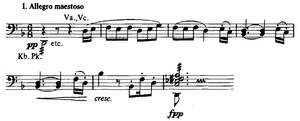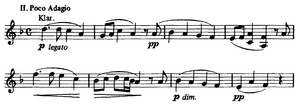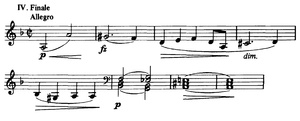7th Symphony (Dvořák)
The Symphony No. 7 in D minor, Op. 70 is a symphony by Antonín Dvořák . It was published as the composer's 2nd symphony during the composer's lifetime.
Emergence
After Dvořák had heard his friend Johannes Brahms' 3rd symphony in 1884 , he too set about composing a new symphony. At this point in time, his last symphony , the 6th , was already written more than four years ago; a time in which Dvořák's compositional style had once again become more mature and sophisticated, which is why the 7th Symphony became a new peak in the composer's symphonic work. It thus represents the beginning of the composer's three great symphonies (symphonies 7, 8 and 9 ).
At the same time as the symphony was being written, Dvořák was appointed honorary member of the London Philharmonic Society, combined with the task of writing a new symphony. Dvořák then performed his 7th symphony for the first time in St. James Hall in London.
To the music
occupation
2 flutes (2nd also piccolo ), 2 oboes , 2 clarinets , 2 bassoons , 4 horns , 2 trumpets , 3 trombones , timpani and strings .
1st movement: Allegro maestoso
The first movement begins with a calm but threatening sound carpet on which a dark melody is spread. According to Dvořák, the beginning of the symphony contains "no superfluous note". The more optimistic second theme is repeatedly threatened and suffocated by the gloomy first theme in the course of the combative first movement. The movement ends, unusual for Dvořák, in pianissimo , in a gloomy mood. A solution to the artistic problems and arguments that were raised in the course of the movement has not yet been achieved; this can only come about in the further course of the symphony.
2nd movement: Poco adagio
The Adagio is also in a combative mood and is permeated with intense bursts of strength from the whole orchestra, which repeatedly interrupt the solemn mood of the main theme with which this movement opens, which is dominated by the woodwinds. The most striking here is a phrase initiated by the flute, which the strings respond with first one, then two tutti hits. Shortly afterwards the trumpet initiates a rousing, urgent movement of the whole orchestra, which represents an enormous development of strength. The movement finally ends again in a calm and peaceful mood, again produced by the woodwinds.
3rd movement: Scherzo. Vivace
The Scherzo is a typical character piece of the Bohemian master. The main theme of the scherzo, with its distinctive dance, is clearly of Bohemian origin and has clear national features, as is usually the case in the scherzi in Dvořák's symphonies . This topic is also in a militant minor and is not free of conflict. Only a short trio seems to promise some calm.
4th movement: Finale. Allegro
The finale begins with a threatening gesture by the orchestra, which immediately takes on an urgent and demanding character. The solution to the musical problems is now to be found. The introduction summarizes all the arguments in the symphony. After a rhythmically distinctive unison string motif, the actual pressing and increasingly optimistic main theme follows. The second theme is then also in a major key (G major) and shows triumphant traits. However, the gloomy mood has not yet been completely defeated, and afterwards it prevails again. This is followed by the combative processing of the main topic in the most violent musical arguments. At the triumphant end of the symphony, these finally flow into a rousing, dramatic coda .
The finale reaches a new intensity of musical expression and quality of thematic processing, even for Dvořák.
effect
The first performance of the symphony took place on April 22, 1885 in London under the direction of the composer. It became one of Dvořák's greatest successes during his lifetime. The symphony was also celebrated in the Bohemian homeland. Their combative character was combined with the patriotic desire of the Czechs for a prosperous nation-state. The printing of the work, on the other hand, turned out to be extremely complicated, since Dvořák's publisher Fritz Simrock only allowed the symphony with restrictions (for example, the dedication to the London Philharmonic Society should not be taken into account and the printing should be in German, not in Czech) and to one wanted to give out a low price. An agreement was only reached after a few years.
Today, the 7th Symphony is one of the outstanding masterpieces of Dvořák in symphonic and complete works and thus belongs to the standard repertoire of the large orchestras.
Individual evidence
- ^ Antonin Dvorak, Symphony No. 7 in D Minor Op.70, Royal Scottish National Orchestra, Neeme Järvi, Chandos Records, 1986, Booklet, p. 2 ( Memento of the original from April 3, 2015 in the Internet Archive ) Info: The archive link was inserted automatically and has not yet been checked . Please check the original and archive link according to the instructions and then remove this notice.
literature
- Hansjürgen Schaefer: Concert book for orchestral music A – F. VEB German publishing house for music, Leipzig 1958.
- Klaus Döge in: Lexicon Orchestermusik Romantik , ed. von Wulf Konold, Munich: Piper 1989, Vol. 1, pp. 202-204
- Harenberg concert guide. Harenberg Kommunikation, Dortmund 1998, ISBN 3-611-00535-5 .
Web links
- 7th Symphony (Dvořák) : Sheet music and audio files in the International Music Score Library Project



